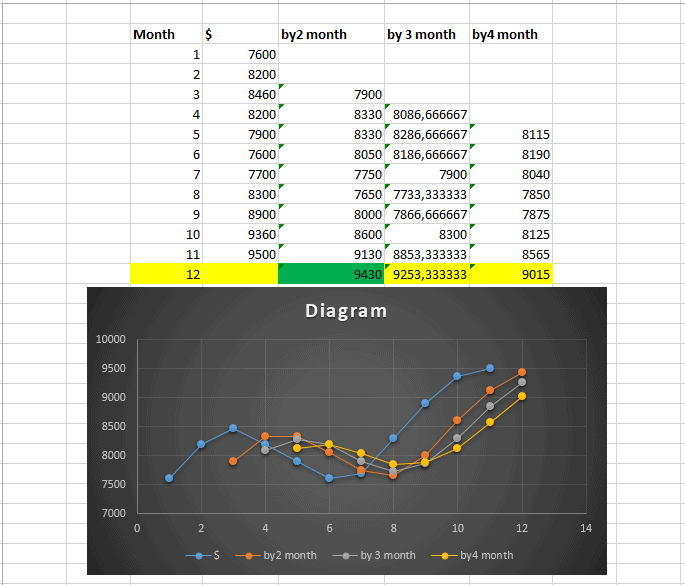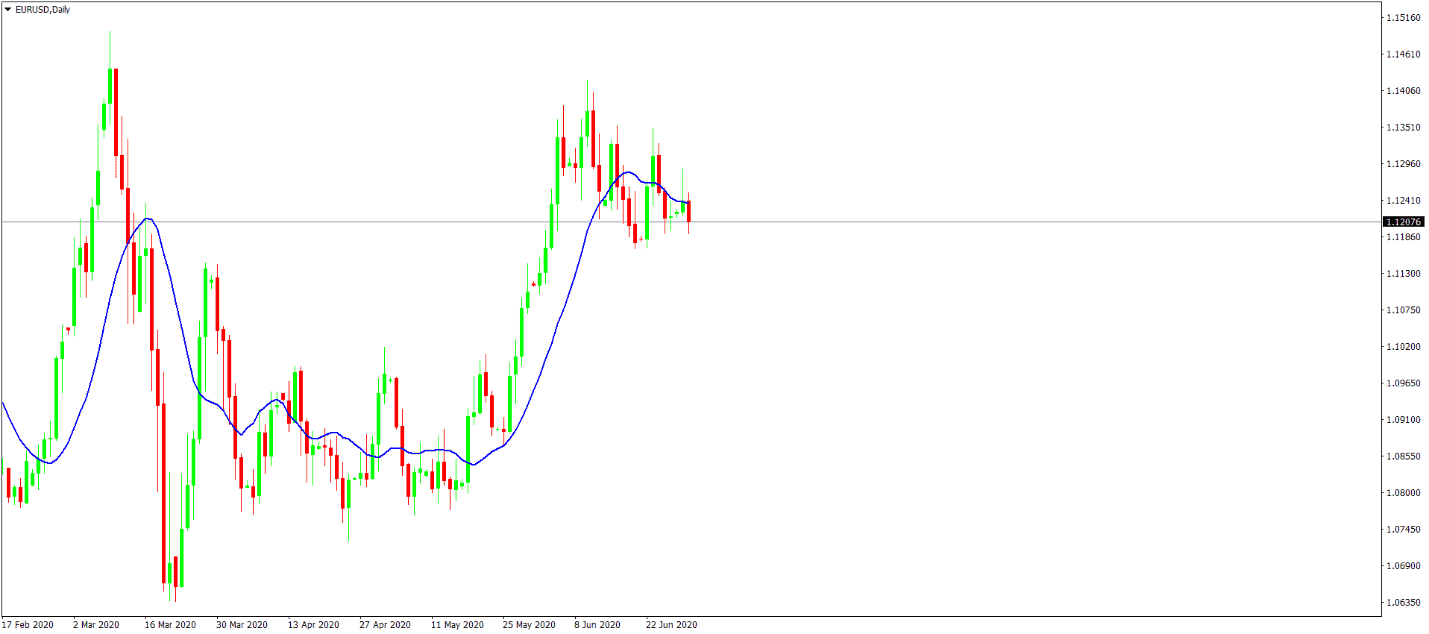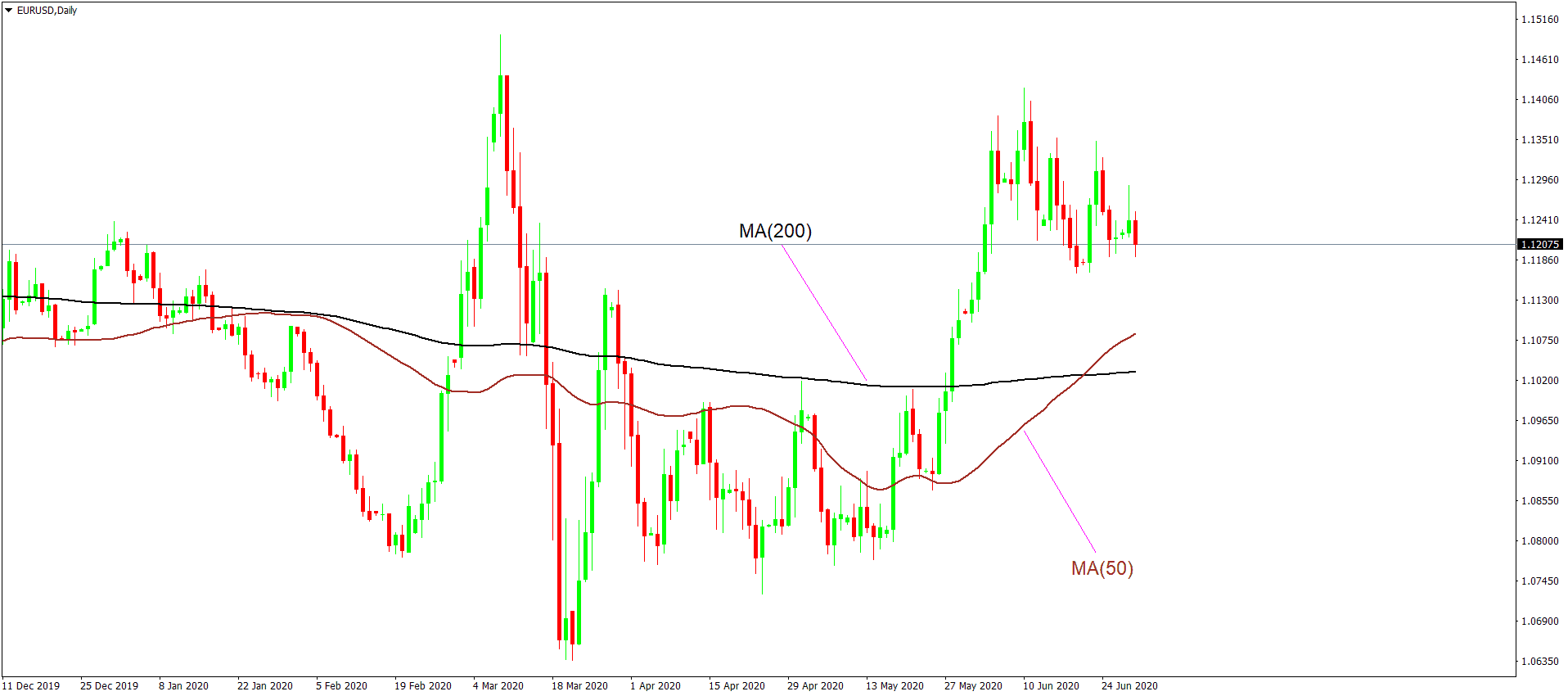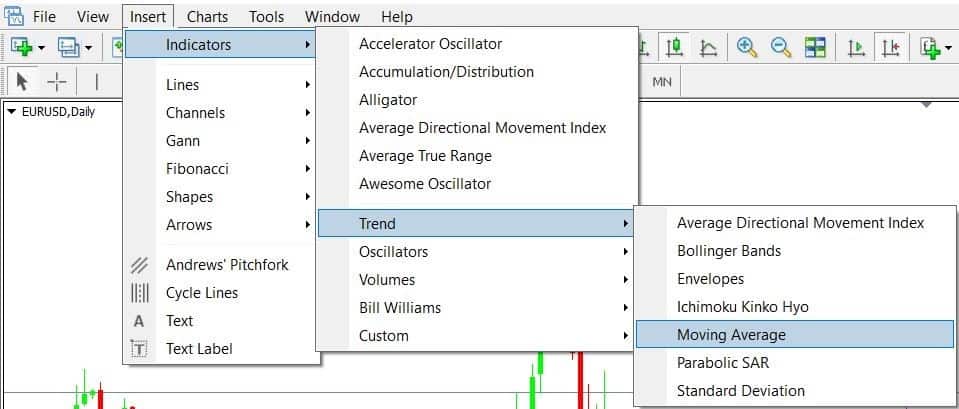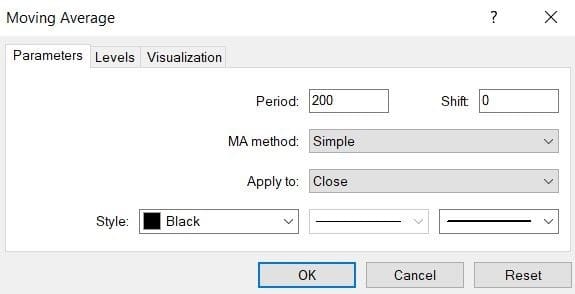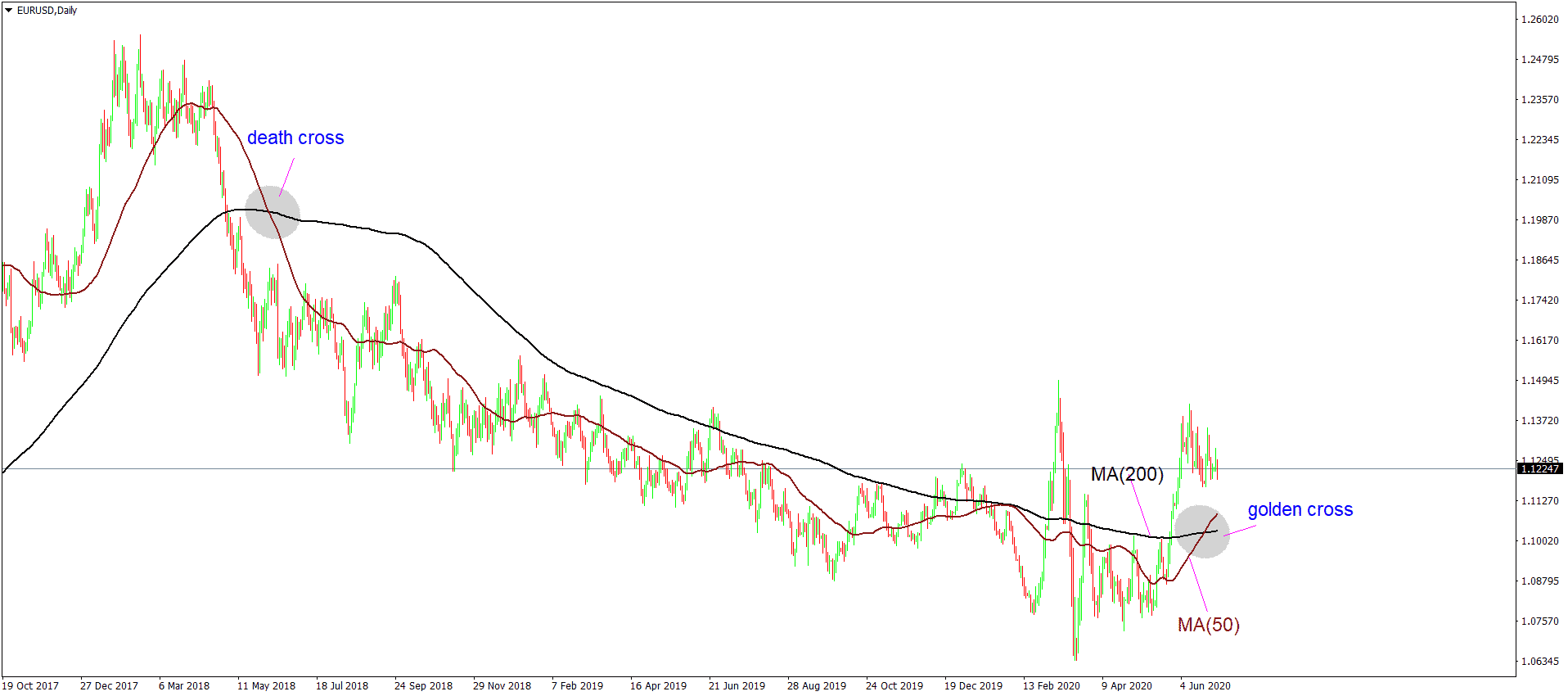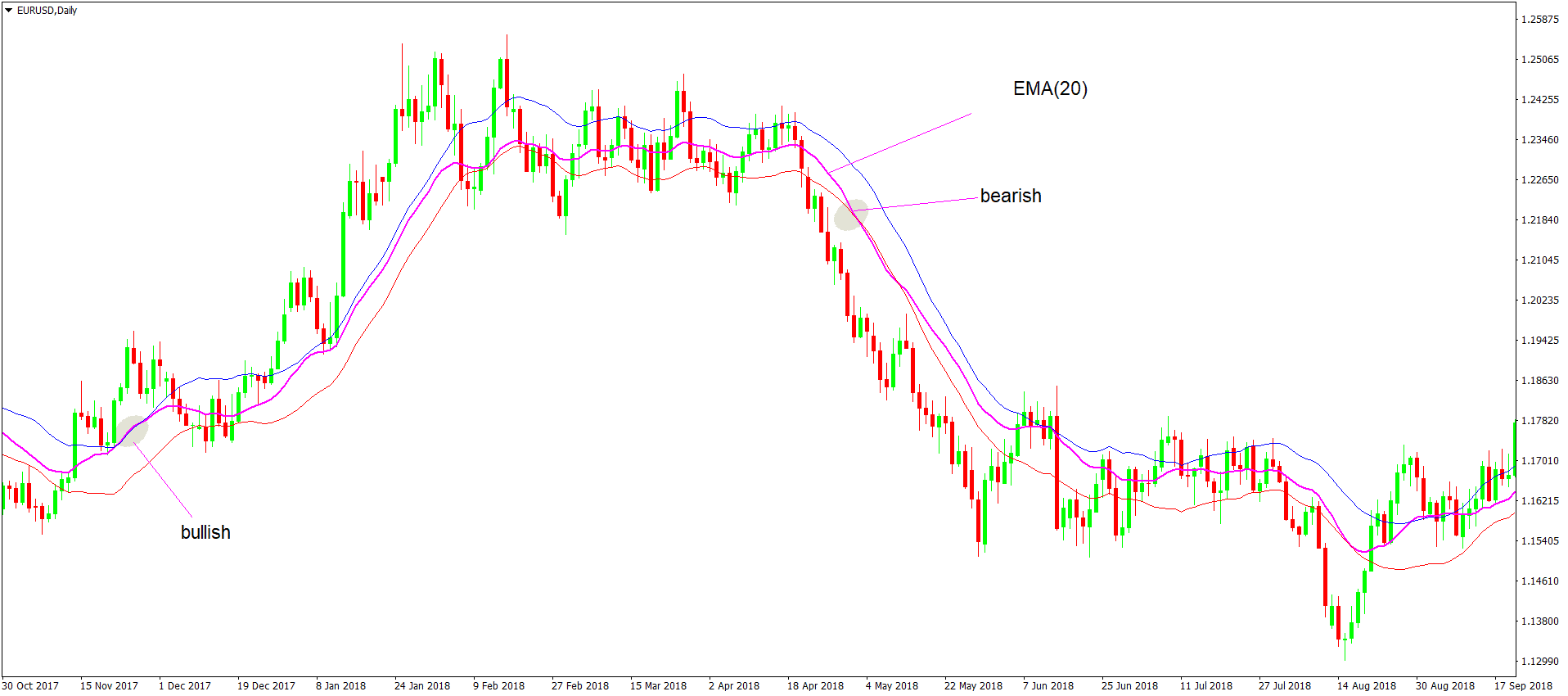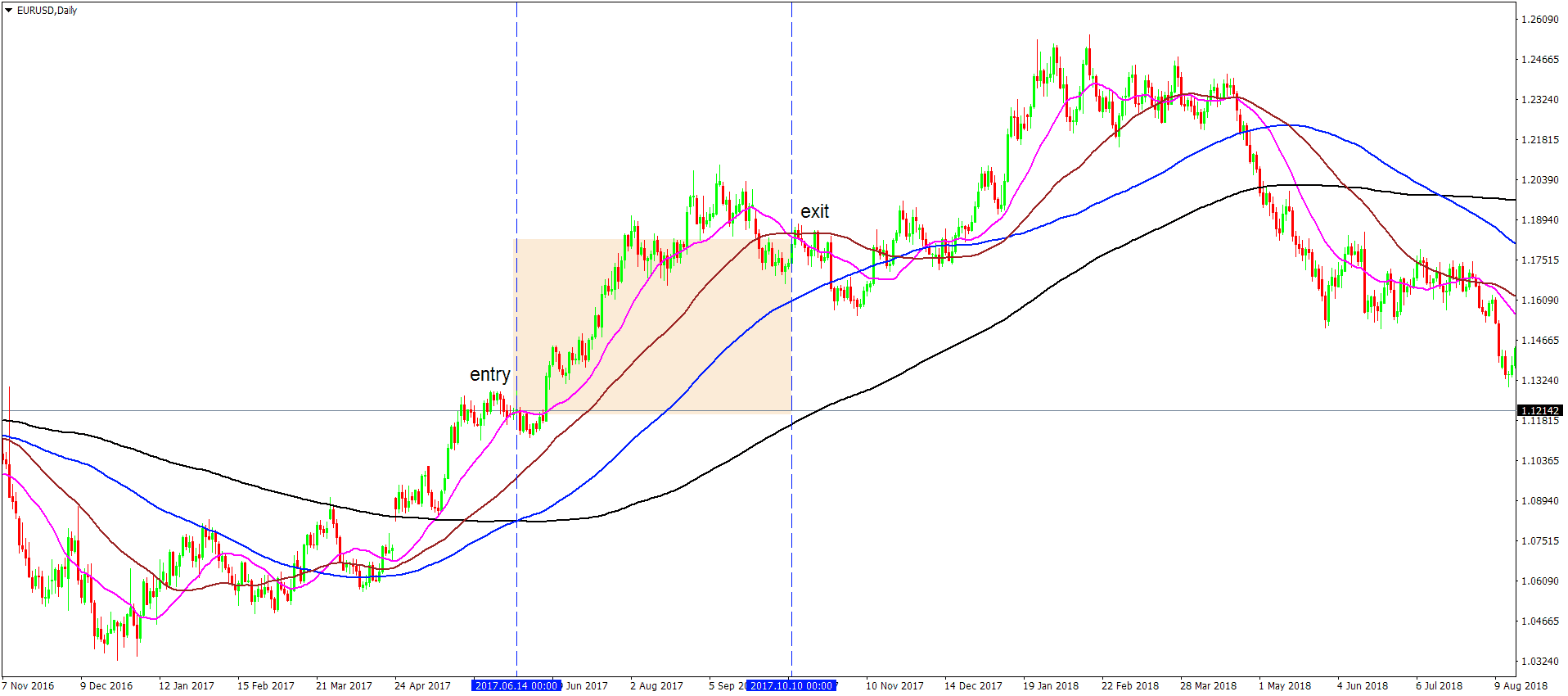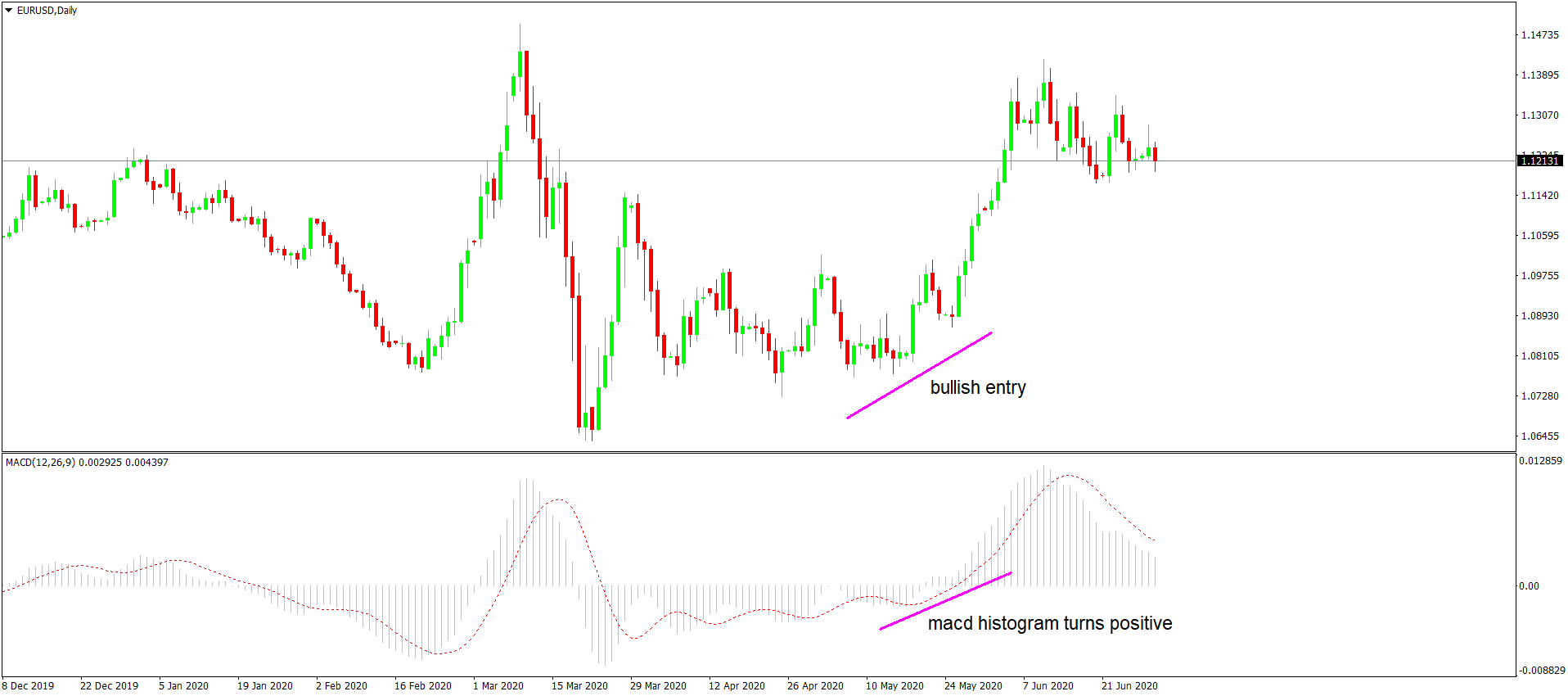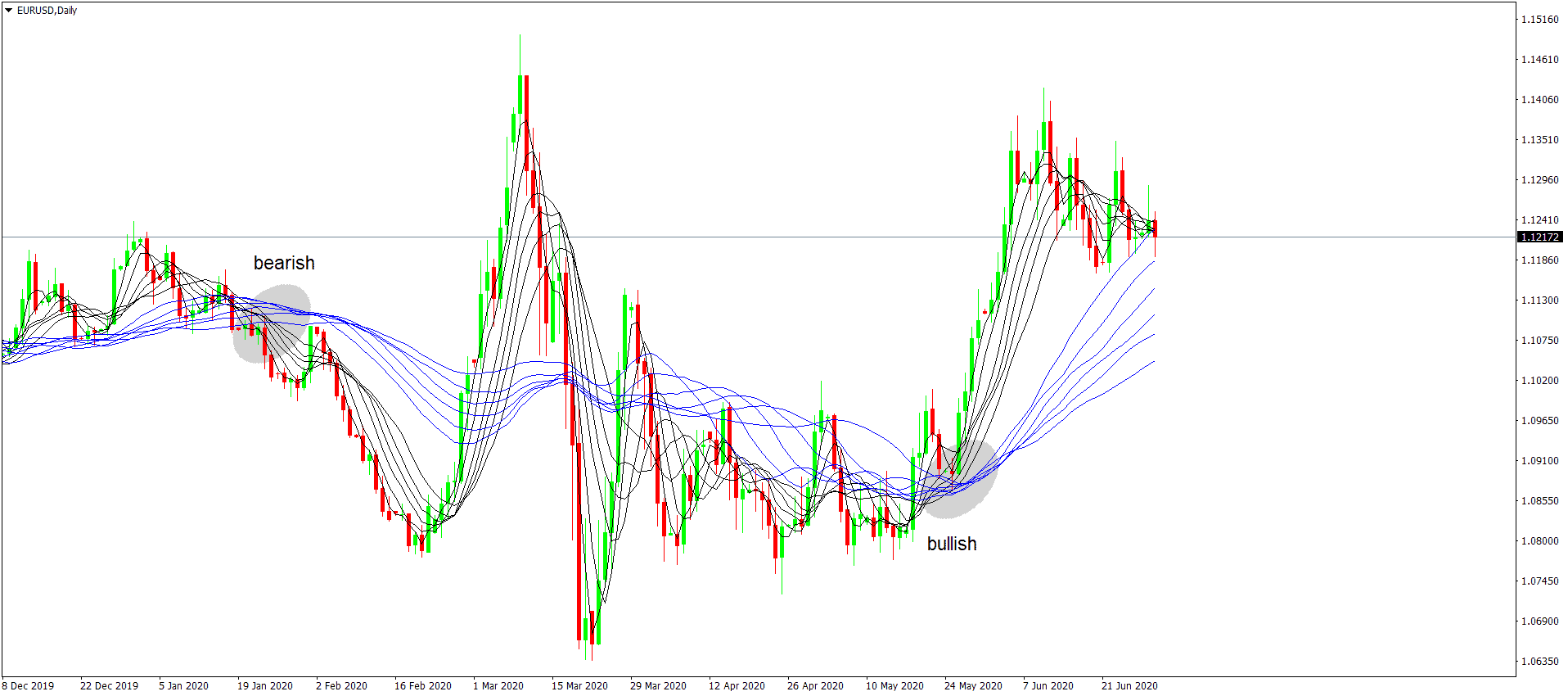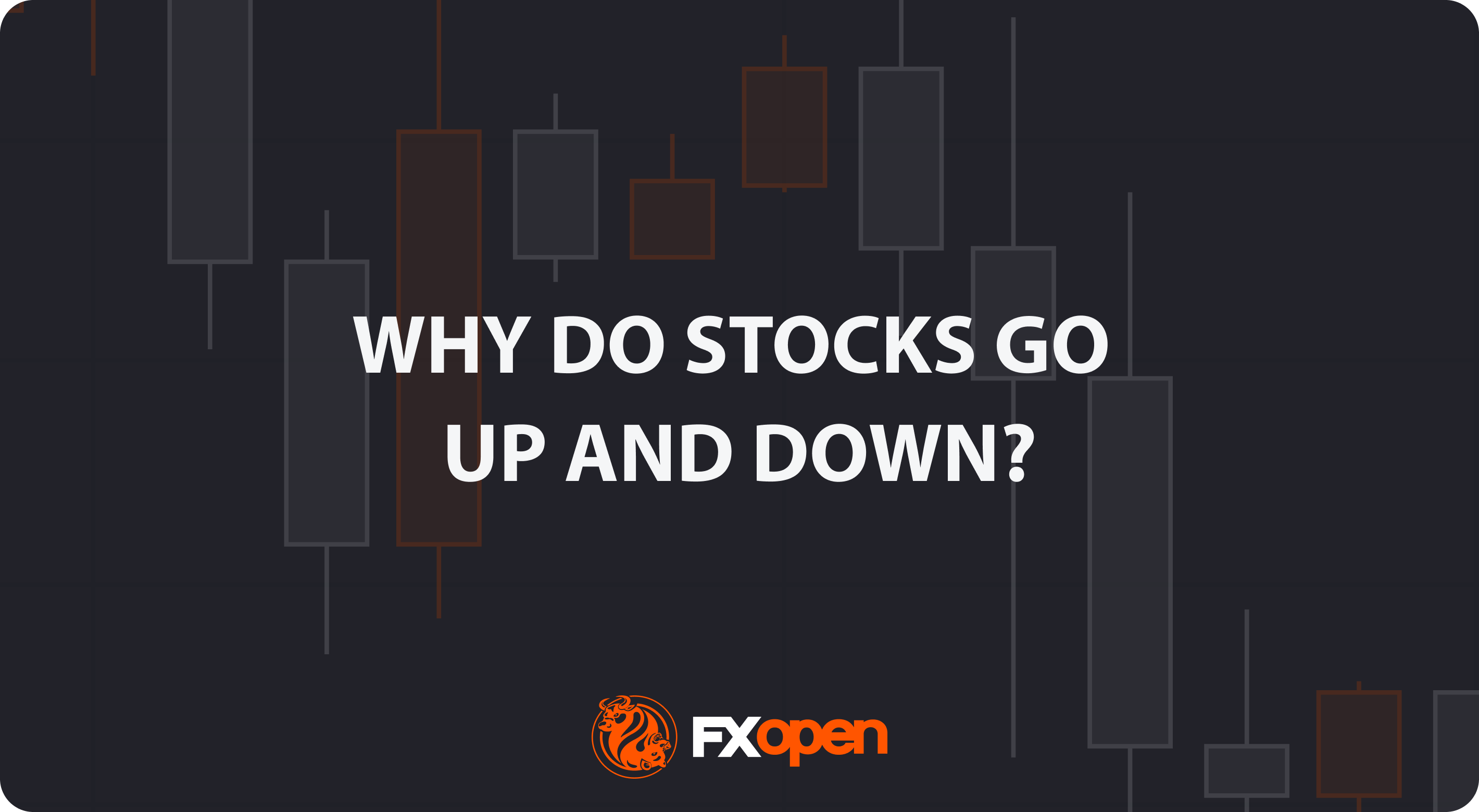FXOpen

What Is a Moving Average (MA)?
A Moving Average or MA — one of the oldest and most powerful technical indicators. MAs exist for a long time, and they are among the first indicators ever created to analyze financial markets.
When traders started to use technical analysis to forecast future prices, the first thing to do was to interpret open and closing levels of the previous trading day. Next, they went back in time to collect more data so to better forecast future levels.
Everything was done manually. Nowadays, computers and modern trading platforms allow traders to compute complex technical indicators with a simple mouse click.
Like the name suggests, the MA averages prices for the past periods. Depending on how the average is made, different types of MAs exist. Also, depending on how many historical periods considers, the MA has a different use for traders.
Why Use MA for Trading?
One of the first things a retail trader learns when starting technical analysis is how to use a moving average. There are so many ways that various strategies exist for each type of trader – scalper, swing trader, or investors.
To start with, a moving average splits the screen into a bullish and bearish market. Typically, when the price is above a moving average, it is said that the market is bullish – traders look for establish long positions. On the other hand, when the price is below a moving average, the price action is bearish, and traders look to sell a currency pair.
For those wondering how does moving averages work, the right answer is that they form strong support and resistance for future prices. Because they project future levels on the right side of the chart, traders know in advance where the market might hesitate. By definition, the more periods the moving average considers, the stronger the support and resistance is.
Moving Average Formula
Depending on the type of moving average used, there is a different moving average formula to apply. The simplest way to understand this indicator is to learn how to calculate a moving average in Excel:
- Fill in the closing prices of a currency pair for the last periods (say, 14 days) – each closing price in one tab
- Use the SUM function to find out the total
- Divide the total by the number of periods considered (14)
- The result is called SMA(14)
You can see the formulae for each type of MA in the section “Types of Moving Averages”.
How to Calculate Moving Averages
Modern trading platforms allow us to skip the Excel to calculate a moving average.
Download example Excel file for calculating MA
Nowadays, the simplest way to calculate a moving average is to open the MetaTrader4 platform (or any other trading platform) and search the MA from the list of indicators available. There is literally no trading platform that do not offer the moving average indicator.
For instance, the SMA(14) explained on the previous paragraph is the blue line seen on the chart below. For each future daily candlestick on the EURUSD chart, the MT4 plots a new value on the SMA(14) line considering the last fourteen daily closing prices.
Different Periods to Consider for Moving Averages
Traders can use a single MA on a chart or multiple MAs. As I mentioned earlier, the bigger the number of periods considered, the stronger the support or resistance level provided by the MA.
One of the biggest challenges traders have is to determine how many days in a moving average to use. The more periods used in a moving average, the flatter it becomes. For this reason, the 200 day moving average is considered “the mother of all moving averages”, meaning that this is the maximum number of periods that traders use. It offers the strongest support and resistance on a chart.
Besides that, another common moving average is the 50 day moving average. Because it considers less periods, it comes closer to the price. Here is the EURUSD daily with the SMA(200) and SMA(50) applied in black, respectively in brown.
How to Choose the Best Period for Your Moving Averages Trading Strategy
Depending on the trading style, one can use a single moving average or multiple ones on the same chart. Also, the timeframe plays a crucial role in determining the importance of a moving average. For example, SMA(200) applied on the daily chart offers far stronger support or resistance than the SMA(200) applied on the hourly or the five-minute chart.
Scalpers (i.e., traders that use technical analysis to quickly enter and exit the markets) use MAs that consider only a few periods, wanting to see the MA closely following the price. Investors with a longer time horizon for their trades, have no such constraints. They would rather use bigger moving averages as they can handle drawdown easier.
How to Setup MAs in the MT4 Platform
The MT4 platform offers an easy way to apply an MA to a chart. First, go on the main menu. From the Insert tab, look for Indicators, and then in the Trend category, the Moving Average indicator appears.
How to Setup MAs in the MT4: INSERT ► Indicators ► Trend ► Moving Average
By selecting it, a pop-up window appears, where one can edit the variables so that the indicator shows the desired values. One can edit the number of periods, the compiling method, the price to which the moving average refers to, but also the color and style.
Types of Moving Averages
The moving average method of compiling past prices gives different types of moving averages. The most popular are the ones listed in the table below:
| MOVING AVERAGE TYPE | DESCRIPTION |
| Simple Moving Average (SMA) | Averages the closing prices of previous periods |
| Exponential Moving Average (EMA) | Averages the closing prices of previous periods but the most recent data has more weight in the final value |
| Weighted Moving Average (WMA) | Multiplies each closing price with a predetermined weight |
Simple Moving Average
An SMA averages the prices of previous periods. It is not mandatory to use the closing prices only – one can adjust the indicator so that it uses the opening price or even an average based on the opening, closing, the high and the low of each period. The SMA is, by far, the most popular moving average.
The formula for SMA is:
SMA = (Price1 + Price2 + ... + Pricen) ÷ n
Pn = the price of an asset at period n;
n = the number of total periods.
Exponential Moving Average
An EMA tends to be more suitable to trend traders because it reduces the gap between the actual price and the moving average. Because of that, traders, especially scalpers, value the EMA more, especially when used in combination with other indicators like the Bollinger bands or envelopes.
The formula for EMA is:
EMA = Pricet × k + EMAy × (1−k)
t = today;
y = yesterday;
N = number of days in EMA;
k = 2 ÷ (N + 1).
You can read more about EMA in the article.
Weighted Moving Average
Just like an EMA, the WMA follows the current price even closer. Therefore, the WMA(200) will be closer to the current price than the SMA(200), so that it further reduces the lag, and traders can react quicker to the change in prices.
The formula for WMA is:
WMA = (Price1 × n + Price2 × (n − 1) + ... Pricen) ÷ (n × (n + 1) ÷ 2))
n = time period.
How I Trade Using Moving Averages
Depending on the trading style used, various moving average strategies exist. A trader may use a moving average as a single indicator, or in combination with other indicators. As a single indicator, it is usually used as a trend indicator. When the market is rising, the moving average provides support, so traders look for dips to buy when the price reaches the moving average. Or traders look to selling spikes when the price reaches the moving average.
Another way I prefer is to use multiple moving averages on the same chart. This way, when they intersect or cross over, it signals a change in market conditions. These are just a couple of examples – many other ones exist.
Moving Average Cross Over
The easiest way to explain this moving average strategy is to use the previous EURUSD example. If we zoom out of the chart, we see the two averages crossing over. In a bearish trend, the fastest moving average is always below the slower one – in this case, MA(50) is below (MA(200) for most of the time.
When the MA(50) crosses below MA(200), it is said that the market forms a death cross – a bearish sing. Conversely, when it crosses above the MA(200), the market forms a golden cross – a bullish sign.
Envelopes Trading Strategies
Envelopes is another trend indicator that serves the same purpose as the Bollinger Bands indicator. Just like the bands, the envelopes “surround” the price action, with the focus on what happens when the price moves beyond the edges.
This trading strategy requires moving average (in this case, the EMA(20)) and two envelopes that can deviate from the EMA. In the example below, the envelopes use a standard deviation of 40% from the EMA(20), and a bearish signal appears when the EMA(20) moves below the lower envelope, while a bullish signal forms when the EMA(20) moves above the upper envelope.
Ribbon Trading Strategy
This strategy refers to the situation when the trader uses multiple moving averages of different periods on the same chart. Also known as the perfect order strategy, this strategy suggests going long when all the fastest moving averages are above the slowest ones, and short when the opposite happens.
The chart below shows the SMA(20) in magenta, SMA(50) in brown, SMA(100) in blue and SMA(200) in black. When they align perfectly, the trader goes long, and the exit is given by the moment the fastest SMA, the magenta one, breaks the perfect order.
Convergence Divergence Trading Strategy
This trading strategy uses an oscillator based on three different moving averages – a fast EMA(12), a slow EMA (26), and an MACD SMA(9). As a side note, the MACD acronym stands for Moving Average Convergence Divergence.
The three moving averages described in the paragraph above are plotted in a separate, smaller window, below the main chart. One way to use the convergence divergence strategy is to wait for the MACD histogram (i.e., the grey vertical bars) to turn positive and then go long the market.
Guppy Multiple
This strategy combines two groups of short and medium-term moving averages. The MAs in the short-term or faster group are 3,5,8,10,12 and 15, shown on the chart below in black. The MA’s in the slower group are 30,35,40,45, 50 and 60, shown on the chart below in blue.
The idea behind this strategy is to wait for the short-term group to move below the long-term group – that is a bearish signal. Conversely, a bullish signal appears when the short-term group moves above the long-term group.
Pros and Cons of Using MA in Trading
Pros of Moving Average
- Visible, making it easier to distinguish between bullish and bearish markets
- Offer strong support and resistance on the bigger timeframes, known in advance
- Have more predictive power if used in combination with an oscillator
Cons of Moving Average
- Often considered lagging indicators
- So popular among retail and professional traders alike that they lost their predictive power if used alone
- They tend to work less on the lower timeframes
My conclusion
As trend indicators, moving averages offer powerful signals to entry and exit a market.
As always, they work best when combined with a sound money management system.
The different types of moving averages (SMAs, EMAs, WMAs), result in various trading strategies. An aspect to keep in mind is that all such strategies are trend-following strategies, even though sometimes traders also look for divergences with the MACD, for example.
To sum up, the main role of a moving average is to split the chart into bullish and bearish markets. From that moment on, the trader can use different trading strategies that best suit the ultimate goal of constantly making a profit.
This article represents the opinion of the Companies operating under the FXOpen brand only. It is not to be construed as an offer, solicitation, or recommendation with respect to products and services provided by the Companies operating under the FXOpen brand, nor is it to be considered financial advice.
Stay ahead of the market!
Subscribe now to our mailing list and receive the latest market news and insights delivered directly to your inbox.



